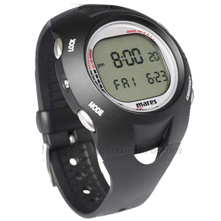
Dive Computer
To avoid decompression sickness during scuba diving, it is critical to monitor your depth and time underwater on every dive. In the past, this would have been done using a watch and a depth gauge, but these functions and many others can now be performed by a dive computer.
The main functions of a dive computer are to monitor your dive time and depth and calculate safe dive schedules. A basic model uses this data to assess the level of nitrogen absorption in your body while you are under the water, and also displays information about your ascent rate, including any stops you may need to make during an ascent to avoid decompression sickness. More advanced models also inform you about the temperature of the water and your air consumption (if linked via a transmitter to your regulator first stage), both for normal air and technical gas mixes. Computers are more flexible than dive tables. Dive tables show how long you can spend at different depths before needing decompression stops. Most tables assume that you spend your entire dive at the greatest depth; computers can make more complicated calculations, including the time spent at all the different depths reached on a dive. Some computers will also schedule deep decompression stops. These reduce the risk of nitrogen microbubbles forming in your body, meaning that less time is spent decompressing in shallow water. When making repeat dives, especially in places where you are not limited by times of tides and slack water, using dive tables instead of a computer may not give you the maximum number of dives you can safely make each day. Computers are also able to monitor your ascent rate accurately. In your dive training, you will be taught to ascend no faster than the smallest exhaled bubble, but it is more accurate to follow a digital readout that tells you the safe ascent rate.
Buying a dive computer
A key consideration when buying a computer is the readability of the display. Too many figures on a small screen are difficult to read—the simplest models are often the best. Choose one with digits that are large enough to read with ease, without any nonessential data on the primary screen. It is also advisable to opt
for a brand with a proven track record. Computers are the most precise way of monitoring your dive, but they are not a foolproof means of avoiding DCS. It is
impossible for data from a computer to exactly reflect your body’s requirements. All models have built-in safety margins, but to be sure of avoiding problems, you
should always dive conservatively, and not push your depths and times to the limit.
Tips and precautions
Safety checks
As you ascend, keep a close watch on your dive computer to make sure that you are not exceeding the maximum ascent rate it recommends.
Malfunction precautions
Never rely solely on a computer. As a precaution against malfunction, it is always worth practicing how to calculate dive times using tables. Although your computer will give early warning of a low battery, make sure you carry back up devices—either a watch and depth gauge, or a second computer, which can be mounted on your console.
Which brand to choose ?

On this question I do not have certain answer , but I would like to recommend 2 major brand Mares and Suunto .I’ve written blogposts about Suunto D9 and Suunto Helo2 .